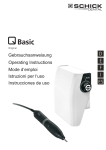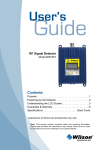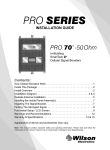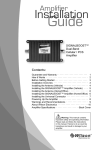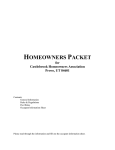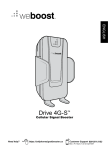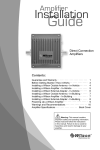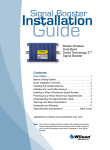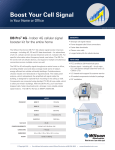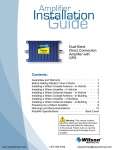Download Installation - Two Way Radios
Transcript
Signal Booster Installation Guide In-Building Wireless Smart Technology Signal Booster Contents: Antenna Options and Accessories. . . . . . . . . . . . . . . . . . . 1 Before Getting Started / How It Works . . . . . . . . . . . . . . . 2 Installation Overview. . . . . . . . . . . . . . . . . . . . . . . . . . . . . 3 Installing a Wilson Electronics Outside Antenna. . . . . . . . 4 Installing a Wilson Electronics Inside Antenna . . . . . . . . . 5 Installing a Wilson Electronics Signal Booster. . . . . . . . . . 6 Powering Up a Wilson Electronics Signal Booster . . . . . . 7 Understanding the Signal Booster Lights . . . . . . . . . . . 8-10 Warnings and Recommendations. . . . . . . . . . . . . . . . . . 11 Factor Conversions. . . . . . . . . . . . . . . . . . . . . . . . . . . . . 12 Distance Coverage Chart . . . . . . . . . . . . . . . . . . . . . . . . 13 Guarantee and Warranty. . . . . . . . . . . . . . . . . . . . . . . . . 14 Signal Booster Specifications . . . . . . . . . . . . . . Back Cover Note: This manual contains important safety and operating information. Please read and follow the instructions in this manual. Failure to do so could be hazardous and result in damage to your signal booster. Wilson ® Electronics, Inc. Installation Instructions for the Following Wilson Signal Boosters: In-Building Wireless Cellular Smart Technology™ 50 dB Signal Booster Model # 801105 FCC ID: PWO8011SB IC: 4726A-8011SB In-Building Wireless Cellular Smart Technology™ 60 dB Signal Booster Model # 801106, Part # 801108, Part # 801110 FCC ID: PWO8011SB IC: 4726A-8011SB In-Building Wireless PCS Smart Technology™ 60 dB Signal Booster Model # 801306 FCC ID: PWO8013SB IC: 4726A-8013SB In-Building Wireless iDEN Smart Technology™ 50 dB Signal Booster Model # 804005 FCC ID: PWO8040SB IC: 4726A-8040SB In-Building Wireless iDEN Smart Technology™ 60 dB Signal Booster Model # 804006 FCC ID: PWO8040SB IC: 4726A-8040SB In-Building Wireless 900 MHz Smart Technology™ 60 dB Signal Booster Model # 801506, Model # 801606, Model # 801170, Model # 801370 Not for sale in the U.S. and Canada. The term “IC” before the radio certification number only signifies that Industry Canada technical specifications were met. Antenna Options & Accessories A D E F G B C H 1 I J A B C D E F G H I J 13 dB 800 MHz Yagi Cellular Antenna (301111) 1900 MHz Yagi PCS Antenna (301124) 800 MHz Yagi Cellular Antenna (301129) Dual-Band Panel Antenna (301135) Dual-Polarity Dome Antenna (301123) Dual-Band Dome Antenna (301121) Splitters (Multiple splitters available) Signal Booster Soft Cases Omni-Directional Antenna (301201) Marine Antenna (301130) Contact Wilson Electronics Technical Support Team with any questions at 866-294-1660 or email: [email protected]. Hours: 7 am to 6 pm MST. Before Getting Started This guide will help you properly install Wilson Electronics In-Building Wireless Smart Technology™ Signal Boosters. It is important to read through all of the installation steps for your particular application prior to installing any equipment. Read through the instructions, visualize where all the equipment will need to be installed and do a soft installation before mounting any equipment. If you do not understand the instructions in full, seek professional help, or contact Wilson Electronics Technical Support at 866-294-1660. Inside this Package • In-building wireless signal booster • AC/DC 110 volt power supply In-building wireless signal booster AC/DC plug-in power supply. (Sold separately in 801175) Additional Required Equipment (sold separately) • Outside antenna (Yagi recommended) • Inside dome, panel or low-profile antenna • Antenna coax cable How it Works Wilson Electronics signal boosters are small, portable, bi-directional devices that deliver service levels consistent with what would be expected in areas of high cell network coverage. They amplify a weak or shadowed signal in mobile, marine and in-building applications. When using a Wilson Electronics signal booster in conjunction with Wilson Electronics antennas, the outside antenna will collect the cell tower signal and send it through the cable to the signal booster. The signal is then amplified and broadcast from the inside antenna to the surrounding area. Cell phones and cellular data cards in that area then communicate with the improved signal. When a cell phone or cellular device transmits, the signal is received by the inside antenna, amplified by the signal booster and broadcast back to the cell tower through the outside antenna. Contact Wilson Electronics Technical Support Team with any questions at 866-294-1660 or email: [email protected]. Hours: 7 am to 6 pm MST. 2 Installation Overview The following steps provide a summary of the signal booster/antenna installation process. However, they are not a substitute for the complete installation instructions on the following pages, which you should read thoroughly. Contact Wilson Electronics Technical Support Department with any questions at 866-294-1660. STEP 1 Install the Outside Antenna Mount the Yagi antenna so that it points toward the cell tower and away from where the inside antenna will be located. Depending on your signal booster model, the two antennas will need 50-75 feet of separation. (See illustrations on pages 5 and 7.) STEP 2 Install the Inside Antenna Select a location in the center of where the signal needs to be amplified. Refer to the instructions included with the inside antenna. (See illustration on page 6 to determine the inside antenna model that best meets your specific needs.) STEP 3 Install the Signal Booster Position the signal booster in a well-ventilated location near a power outlet. Attach the outside and inside antennas to the signal booster using Wilson 400 low loss coax cable (available from Wilson Electronics). STEP 4 Power up the Signal Booster IMPORTANT! Before connecting the power supply, ensure that both the inside and outside antenna cables are connected. Also ensure that all cell phones and cellular data cards within 50 feet of the inside antenna are turned off. Plug in the supplied 6-volt power supply into the signal booster and then into a wall outlet (power supply sold separately in 801175). STEP 5 Check the Signal Booster Lights The PWR light should be green, indicating that the signal booster has power. If all other lights are also green, the signal booster is operating properly; however, if you do not have the desired signal coverage area, refer to pages 5, 6, 9 and 10. Note: if you are using an outdoor Yagi antenna, it must be adjusted for maximum signal. 3 Contact Wilson Electronics Technical Support Team with any questions at 866-294-1660 or email: [email protected]. Hours: 7 am to 6 pm MST. Installing a Wilson Electronics Outside Antenna Select a location on the roof of the building to install the outside antenna, using a cell phone in test mode to find the strongest signal from the cell tower. RF Signal Cell Tower Yagi External Antenna ! Warning: Never point the front of the Yagi antenna toward the inside antenna - oscillation will result, causing amber light and gain reduction. For test mode help, visit www.wilsonelectronics.com or call Technical Support at 866-294-1660. Follow the specific antenna installation instructions included with the outside antenna. CORRECT Pointing toward cell tower NOT CORRECT Lightning protection is recommended for all in-building installations. Take extreme care to ensure neither you nor the antenna come in contact with any electrical power lines. A Yagi antenna must be installed horizontally with the elements vertical and the drip hole on the bottom. Ensure there are three feet of clearance in all directions surrounding the antenna. ! Warning: The outside antenna must be installed on an outdoor permanent structure with a separation of at least 20 feet from all persons during normal operation. Contact Wilson Electronics Technical Support Team with any questions at 866-294-1660 or email: [email protected]. Hours: 7 am to 6 pm MST. 4 Installing a Wilson Electronics Inside Antenna Select a suitable location for the inside antenna, preferably in the center of where the signal needs to be amplified. To determine signal strength and coverage distance, refer to page 12 of this installation guide. Follow the specific antenna installation instructions included with the inside antenna. Wilson Electronics has several inside antenna options. The dome and panel antennas are the most popular for in-building applications. For a square room, a dome antenna will provide better coverage. (A) For a rectangular room, a panel antenna will provide better coverage. (B) In some cases, multiple inside antennas may be required (C & D). A signal may be “split” by using a splitter. If using more than one inside antenna, a separation of at least 20 feet is necessary between inside antennas. = Dome Antenna = Amplifier = Panel Antenna = Splitter A C B D Connect the coax cable from the signal booster to the inside antenna. For distances of 20 feet or more, use Wilson 400 low loss coax cable to prevent significant signal loss. Warning: 5 An inside antenna must have a separation distance from all persons that is at least 12 inches for the 5.2 dBi dome antenna and 15 inches for the 7 dBi panel antenna. Contact Wilson Electronics Technical Support Team with any questions at 866-294-1660 or email: [email protected]. Hours: 7 am to 6 pm MST. Installing a Wilson Electronics Signal Booster Select a location to install the signal booster that is away from excessive heat, direct sunlight, moisture and that has proper ventilation. Do not place the signal booster in an air-tight enclosure. Recommended installation locations for in-building signal boosters are: • On a wall • On the ceiling • Near a power outlet Run the outside antenna cable to the signal booster and attach it to the N-Female connector labeled “outside antenna” on the signal booster. Run the inside antenna cable to the signal booster and attach it to the N-Female connector labeled “inside antenna” on the signal booster. Note: Be careful when plugging the connector in so as not to damage the center pins on the connectors. Antenna Separation Point Yagi antenna away from inside antenna Outside Antenna 1900 MHz Yagi Antenna Shown 50 feet minimum separation between inside and outside antenna for 50 dB cellular amplifier Cell Site 68 feet for 60 dB PCS amplifier 75 feet for 60 dB cellular amplifier Inside Antenna Optional Dome Antenna Shown Supports Multiple Users Amplifier AC/DC Power Supply Connect the outside antenna to the signal booster with Wilson 400 low loss coax cable (available from Wilson Electronics). Place the inside antenna in the center of the area needing the amplified signal. It is important to have at least 50 feet of separation between the inside and outside antennas for the 50 dB signal boosters, 68 feet of separation distance for the 60 dB PCS signal boosters and at least 75 feet of separation distance for the 60 dB cellular signal boosters. Warning: Connecting the signal booster directly to the cell phone with use of an adapter will damage the cell phone. Contact Wilson Electronics Technical Support Team with any questions at 866-294-1660 or email: [email protected]. Hours: 7 am to 6 pm MST. 6 Powering up a Wilson Electronics Signal Booster 1. IMPORTANT! Ensure that all cell phones and cellular data cards within 50 feet of the inside antenna are turned off. 2. To verify proper installation of the signal booster and antennas, make sure that the distance between the inside and outside antennas is a minimum of 50 feet for the 50 dB signal booster, 68 feet of separation distance for the 60 dB PCS signal booster, and 75 feet for the 60 dB cellular signal booster. 3. If you are using an outside Yagi antenna, never point the front of the Yagi toward the inside antenna. 4. Ensure that both the outside antenna coax cable and the inside antenna coax cable are connected to the signal booster before powering up the signal booster. 5. Plug the 6-volt power supply into the signal booster input marked “power” (carefully, to avoid damaging the center pin) and then into a wall outlet. Warning: Use only the power supply provided in this package. Use of a non-Wilson Electronics product may damage your equipment (power supply sold separately in 801175). Warning: Verify that both the outside antenna and the inside antenna are connected to the signal booster before powering up the signal booster. NOTE: The aluminum casing of a Wilson Electronics signal booster will adjust very quickly to the ambient temperature of its environment. For example, in the summer, when the attic of a house can easily exceed 100 degrees Fahrenheit, the signal booster temperature may be 10 or more degrees higher. The casing will be hot to the touch. Such high temperatures will not damage the signal booster, nor do they pose a fire risk. As recommended in these instructions, install the signal booster in a location with adequate ventilation. Keep the area free of items that could block air flow to the signal booster. 7 Contact Wilson Electronics Technical Support Team with any questions at 866-294-1660 or email: [email protected]. Hours: 7 am to 6 pm MST. Understanding the Signal Booster Lights If your signal booster has this light configuration refer to the instructions below. The signal booster is equipped with sensitive electronics designed to detect signal booster oscillation or cell phone overload, both of which can hamper signal booster performance. The signal booster is designed to automatically reduce gain or, if necessary, shut down to prevent or compensate for these conditions. Oscillation or overload can be caused by improper equipment installation -- understanding the signal booster lights will help you identify and solve potential problems. OSC 40 50 60 When the signal booster is initially powered on, the 60 light will turn green. This indicates the signal booster is working at the proper gain level. OSC 40 50 60 If the 50 light is green, an oscillation has been detected and the signal booster is powering down. Verify that the outside Yagi antenna is pointed away from the inside antenna and not across the roof of the building. If need be, redirect the Yagi antenna so that it is pointing away from the inside antenna. Then, reset the signal booster by disconnecting and reconnecting the power supply. OSC 40 50 60 If the 40 light is green, the signal booster is continuing to power down. Try operating the cell phone farther away from the inside antenna. If need be, redirect the Yagi antenna so that it is pointing away from the inside antenna. Then, reset the signal booster by disconnecting and reconnecting the power supply. OSC 40 50 60 If the OSC light is solid red, the signal booster has shut down to prevent oscillation. Try operating the cell phone farther away from the inside antenna. Verify that the outside Yagi antenna is pointed away from the inside antenna and not across the roof of the building. If need be, redirect the Yagi antenna so that it is pointing away from the inside antenna. Then, reset the signal booster by disconnecting and reconnecting the power supply. OSC 40 50 60 If the OSC light is blinking red, the signal booster has shut down to prevent a receive overload. Try moving the outside antenna further away from the cell tower. Contact Wilson Electronics Technical Support Team with any questions at 866-294-1660 or email: [email protected]. Hours: 7 am to 6 pm MST. 8 Understanding the Signal Booster Lights If your signal booster has this light configuration refer to the instructions below. The signal booster is equipped with sensitive electronics designed to detect signal booster oscillation or cell phone overload, both of which can hamper signal booster performance. The signal booster is designed to automatically reduce gain or, if necessary, shut down to prevent or compensate for these conditions. Oscillation or overload can be caused by improper equipment installation -- understanding the signal booster lights will help you identify and solve potential problems. When the signal booster is initially powered on, the 65 light will turn green. This indicates the signal booster is working at the proper gain level. OSC 45 55 65 OSC 45 55 65 If the 55 light is green, an oscillation has been detected and the signal booster is powering down. Verify that the outside Yagi antenna is pointed away from the inside antenna and not across the roof of the building. If need be, redirect the Yagi antenna so that it is pointing away from the inside antenna. Then, reset the signal booster by disconnecting and reconnecting the power supply. OSC 45 55 65 If the 45 light is green, the signal booster is continuing to power down. Try operating the cell phone farther away from the inside antenna. If need be, redirect the Yagi antenna so that it is pointing away from the inside antenna. Then, reset the signal booster by disconnecting and reconnecting the power supply. OSC 45 55 65 If the OSC light is solid red, the signal booster has shut down to prevent osciallation. Try operating the cell phone farther away from the inside antenna. Verify that the outside Yagi antenna is pointed away from the inside antenna and not across the roof of the building. If need be, redirect the Yagi antenna so that it is pointing away from the inside antenna. Then, reset the signal booster by disconnecting and reconnecting the power supply. OSC 45 55 65 9 If the OSC light is blinking red, the signal booster has shut down to prevent a receive overload. Try moving the outside antenna further away from the cell tower. Contact Wilson Electronics Technical Support Team with any questions at 866-294-1660 or email: [email protected]. Hours: 7 am to 6 pm MST. Understanding the Signal Booster Lights Wilson ® Electronics, Inc. If your signal booster has this light configuration refer to the instructions below. TM The signal booster is equipped with sensitive electronics designed to detect signal booster oscillation or cell phone overload, both of which can hamper signal booster performance. The signal booster is designed to automatically reduce gain or, if necessary, shut down to prevent or compensate for these conditions. Oscillation or overload can be caused by improper equipment installation -- understanding the signal booster lights will help you identify and solve potential problems. PWR A B C D The power light will turn green when the signal booster is initially powered on. PWR A B C D A BLINKING red light indicates a cell tower overload. Move the outside antenna further away from the cell tower. PWR A B C D When the D light is green, the signal booster is working at proper gain level (peak performance). PWR A B C D If light C is green but D is out, an oscillation has been detected and the signal booster is powering down. To remedy this, turn the outside antenna slightly away from the inside antenna until the D light turns green. PWR A B C D If light B is green and C and light D are off, an oscillation has been detected and the signal booster is powering down. To remedy this, turn the outside antenna slightly away from the inside antenna until the D light turns green. PWR A B C D If light A is solid red, the signal booster has shut down to prevent an oscillation. To remedy this, turn the outside antenna slightly away from the cell tower. The signal booster will reset automatically but may also be reset by disconnecting and reconnecting the power supply. Contact Wilson Electronics Technical Support Team with any questions at 866-294-1660 or email: [email protected]. Hours: 7 am to 6 pm MST. 10 Warnings and Recommendations Warning: The Yagi antenna must always be located so the back or side points to the inside antenna. Never point the front of the Yagi antenna toward the inside antenna – oscillation will result, causing amber light and gain reduction. Warning: The outside antenna must be installed on an outdoor permanent structure with a separation of at least 20 feet from all persons during normal operation. Warning: Connecting the signal booster directly to the cell phone with use of an adapter will damage the cell phone. Warning: Connect both the outside and inside antenna cables to the signal booster before powering up the signal booster. Warning: Use only the power supply provided in this package. Use of a nonWilson Electronics product may damage your equipment. Warning: RF Safety: An inside antenna must have a separation distance from all persons that is at least 12 inches for the 5.2 dBi dome antenna and 15 inches for the 7 dBi panel antenna. Lightning protection is recommended for all in-building installations. Finding Signal Strength and Calculating Coverage Distance Signal strength and the corresponding coverage distance you can expect to achieve with your signal booster/antenna system are based on a combination of several factors: the received signal strength of your cell phone alone, the signal gain achieved by your signal booster and antennas and the signal loss from cables, taps and splitters you may be using. To calculate your approximate signal coverage distance, you can enter this information into our Coverage Area Calculator on the Technical Support page on our website (www. wilsonelectronics.com). If you prefer, you can manually calculate your approximate signal coverage distance using the instructions on this and the following two pages. First, measure the Outside Signal Level (OSL) at the intended outside antenna location using a cell phone in test mode. (For assistance, visit the Phone Test Modes section on the Technical Support page on our website or call 866-294-1660.) The OSL will always be a negative number. (Even if the cell phone shows a positive number, you will need to change it to a negative for this calculation.) Maximum signal strength is usually about -50. When the signal weakens to about -100 or worse, the call may be dropped. Depending on the model, your signal booster gain (AG) will be 50, 60 or 65 dB (see the label on your signal booster or the specification table on the back cover of this guide). Your inside and outside antennas will also add signal gain, again depending on the antenna models you are using (see the table on page 13). You will also experience some signal loss from cables, splitters and taps used to connect your system (see the table on page 13). 11 Contact Wilson Electronics Technical Support Team with any questions at 866-294-1660 or email: [email protected]. Hours: 7 am to 6 pm MST. Factor Conversions Using the table below, find and circle the appropriate decibel (dB) numbers that correspond to the equipment in your particular system. Be sure to choose your numbers from the appropriate frequency column based on the service you receive (iDEN, Cellular or PCS). Frequency iDEN 851 Cellular 869 PCS 1930 Low Profile (inside) +3 dB +3 dB +3 dB Dual-Band Panel (inside) +7 dB +7 dB +7 dB Dual-Band Dome (inside) +2 dB +2 dB +2 dB Dual-Polarity Dome (inside) +5 dB +5 dB +5 dB Yagi 806-939 MHz Cellular (outside) +13 dB +13 dB +13 dB Yagi 800-900 MHz Cellular (outside) +10 dB +10 dB +10 dB Yagi 1800-1900 MHz PCS (outside) +14 dB +14 dB +14 dB 20’ RG 58 -4 dB -4 dB -7 dB 20’ Wilson 400 -3 dB -3 dB -4 dB 30’ Wilson 400 -3 dB -3 dB -5 dB 50’ Wilson 400 -4 dB -4 dB -7 dB 100’ Wilson 400 -7 dB -7 dB -10 dB -3 dB -3 dB -3 dB -6/-10 dB -6/-10 dB -6/-10 dB Antenna Factor (AF) Cable Factor (CF) Splitter Factor (SF) Tap Factor (TF) (depends on model - refer to tap label) Use the following formula to calculate your Signal Strength (S). Write in your numbers as appropriate. Be sure to account for the length of all cable, inside and out. Add up the numbers for all taps and/or splitters (if you are not using any, enter 0). Remember, AG and AF will be positive numbers; OSL, CF, TF, SF and S will be negative. OSL + AG + AF + CF + SF + TF = S Once you have calculated your signal strength, use the graph on the following page to determine approximate coverage distance. See below for a sample calculation. Sample Signal Strength and Coverage Calculation This example assumes an OSL of -90, use of a 60 dB cellular signal booster, an 806-939 MHz Yagi antenna and a low profile inside antenna with 100 total feet of inside and outside 9913 cable with no splitters or taps. OSL AG AF CF SF TF -90 (always a negative number) found on cell phone in test mode +60 gain +16 dB gain (+13 dB for the Yagi antenna and +3 dB for the low-profile antenna) -7 dB loss 0 (none used) 0 (none used) Formula: -90 + 60 + 16 + -7 + 0 + 0 = -21 With a signal strength of -21, coverage distance would be approximately 120 feet from the inside antenna. Contact Wilson Electronics Technical Support Team with any questions at 866-294-1660 or email: [email protected]. Hours: 7 am to 6 pm MST. 12 13 Contact Wilson Electronics Technical Support Team with any questions at 866-294-1660 or email: [email protected]. Hours: 7 am to 6 pm MST. 0 50 100 150 200 250 300 350 400 COVERAGE DISTANCE (ft) FORMULA SOLUTION COVERAGE DISTANCE IN FT -10 391 / 157 -15 220 / 88 -20 122 / 50 SIGNAL STRENGTH 70 / 28 -25 39 / 16 -30 22 / 9 -35 NOTE: Your actual coverage may vary from at least half to twice the indicated distance due to signal fading, obstructions or reflections. When you complete the calculation on page 13, find your Signal Strength number on the horizontal axis (-10 to -40). Then, follow the nearest vertical gridline upward to where it intersects with the 800 MHz or 1900 MHz line, as appropriate. You can then determine your approximate coverage distance in feet, as indicated on the vertical axis (0 to 400). 1900 MHz 800 MHz INSIDE BUILDING COVERAGE DISTANCE -40 12 / 5 30-Day Money-Back Guarantee All Wilson Electronics products are protected by Wilson Electronics 30-day money-back guarantee. If for any reason the performance of any product is not acceptable, simply return the product directly to the reseller with a dated proof of purchase. 1-Year Warranty Wilson Electronics signal boosters are warranted for one (1) year against defects in workmanship and / or materials. Warranty cases may be resolved by returning the product directly to the reseller with a dated proof of purchase. Signal boosters may also be returned directly to the manufacturer at the consumer’s expense, with a dated proof of purchase and a Returned Material Authorization (RMA) number supplied by Wilson Electronics. Wilson Electronics shall, at its option, either repair or replace the product. Wilson Electronics will pay for delivery of the repaired or replaced product back to the original consumer within the continental United States. This warranty does not apply to any signal boosters determined by Wilson Electronics to have been subjected to misuse, abuse, neglect, or mishandling that alters or damages physical or electronic properties. The Manufacturer’s rated output power of this equipment is for single carrier operation. For situations when multiple carrier signals are present, the rating would have to be reduced by 3.5 dB, especially where the output signal is re-radiated and can cause interference to adjacent band users. This power reduction is to be by means of input power or gain reduction and not by an attenuator at the output of the device. Operation is subject to the following two conditions: (1) This device may not cause interference and (2) this device must accept any interference, including interference that may cause undesired operation of this device. Disclaimer: The information provided by Wilson Electronics, Inc. is believed to be complete and accurate. However, no responsibility is assumed by Wilson Electronics, Inc. for any business or personal losses arising from its use, or for any infringements of patents or other rights of third parties that may result from its use. Copyright © 2010 Wilson Electronics, Inc. All rights reserved. Wilson ® Electronics, Inc. 3301 East Deseret Drive, St. George UT 84790 For additional Technical Support visit www.wilsonelectronics.com Phone: 866-294-1660 Fax: 435-656-2432 Contact Wilson Electronics Technical Support Team with any questions at 866-294-1660 or email: [email protected]. Hours: 7 am to 6 pm MST. 14 In-Building Wireless Signal Booster Specifications (GSM & Cellular) Model/Part Number Cellular # 801105/801175 Cellular # 801106 Cellular #801108 Cellular #801110 Cellular #801165 Frequency Uplink 824-849 MHz 824-849 MHz 824-835 MHz 835-849 MHz 824-849 MHz Downlink 869-894 MHz 869-894 MHz 869-880 MHz 880-894 MHz 869-894 MHz Gain 50 dB 60 dB Channel A 60 dB Channel B 60 dB 65 dB Max Output 3 watts AGC Limit (uplink/downlink) + 30 dBm / + 30 dBm Noise Figure 3-4 dB typical Flatness (uplink/downlink) ± 2.5 dB Isolation (uplink/downlink) > 90 dB Power Requirements Input: 100-240 V AC 50/60 Hz 0.6 A / Output: 6 V DC 3 A Connectors N-Female 50 ohms Dimensions 5.6 x 3.6 x 1.7 (inch) / 14.2 x 9.1 x 4.4 (cm) Weight 1.5 lbs / .7kg In-Building Wireless Signal booster Specifications (iDEN, PCS, EGSM & DCS) Model/Part Number iDEN # 804005 iDEN # 804006 PCS # 801306 PCS # 801365 EGSM #801506 DCS #801606 Not for sale in the U.S. or Canada Frequency Uplink 806-821 MHz 806-821 MHz 1850-1910 MHz 1850-1910 MHz 880-915 MHz 1710-1755 MHz Downlink 851-866 MHz 851-866 MHz 1930-1990 MHz 1930-1990 MHz 925-960 MHz 1805-1880 MHz Gain 50 dB 60 dB Max Output 3 watts AGC Limit (uplink/downlink) + 30 dBm / + 30 dBm Noise Figure 3-4 dB typical Flatness (uplink/downlink) ± 2.5 dB 60 dB 65 dB 60dB 2 watts 60dB 3 watts +30 dBm / +30 dBm 4 dB typical 3 dB typical ± 4 dB Isolation (uplink/downlink) > 90 dB Power Requirements Input: 100-240 V AC 50/60 Hz 0.6 A / Output: 6 V DC 3 A Connectors N-Female 50 ohms Dimensions 5.6 x 3.6 x 1.7 (inch) / 14.2 x 9.1 x 4.4 (cm) Weight 1.5 lbs / 0.7 kg Part #110434 - Rev29 / 11.19.10

















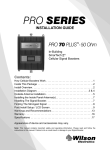
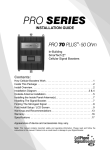
![80-00 [更新済み]](http://vs1.manualzilla.com/store/data/006650731_2-ee5a274f1c8f345559eec423601c9443-150x150.png)



